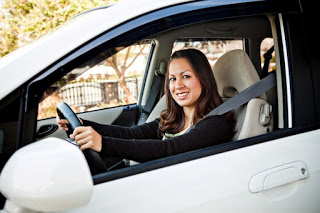Tag Archive: text and driving

Commit to Being a Safer Driver
April 10, 2012
Many people will make a commitment to losing weight, to do better in school, get out of debt, or join a fitness club. The sad part of making these resolutions is they are often very hard to keep and people often fail within the first few weeks or months of trying. One resolution that is easy to keep is to become a safer driver. It’s easy to achieve because licensed teenage drivers are in their vehicles every day giving them the opportunity to practice safe driving habits.
In today’s world of driving, drivers are trying to multitask behind the wheel with negative results. According to the Boston Focus Group Study of Bad Drivers:
- 77% of drivers admit to talking or texting while driving
- 60% admit to eating while driving
- 50% admit to making obscene or rude gestures or comments to other drivers, particularly those who cut in front of them
- 50% admit to almost falling asleep while behind the wheel
- Countless teens are getting behind the wheel of their vehicle drunk, high or buzzed.
Making a commitment to eliminate those types of activities from your daily driving habits isn’t hard to do. Let’s look at a few more:
- Ditch the cell phone because using a cell phone or texting while driving can be as dangerous or deadly as drunk driving. One way of doing this is to keep your cell phone far enough away that you will not be tempted to use it. Keep it turned off and let all messages go to voicemail. You can also purchase a cell phone blocker to block calls and/or texts while the vehicle is in motion. Only use a cell phone when driving for emergencies.
- Drive within the posted speed limit. When you speed you are increasing your chances of getting into a crash, injuring or killing yourself or others. Don’t be a follower and speed just because you think everyone else does. Be a leader and show others you obey the law.
- Fast food is often a teens lifeline but not while you are driving. If you need a snack, go into the restaurant or park and eat and then continue your journey.
- Always look when entering a lane of traffic or passing another car. Get into the habit of using your turn signals and side-view mirrors and don’t forget those inexpensive “blind-spot mirrors” can make the difference of getting into a crash or not.
- When someone cuts you off, take a deep breath, count to ten and let it go. Road rage accomplishes nothing except putting you in danger of a crash while you try to catch up to the other driver.
- Wear your seatbelt. Not because it’s the law, but because it will save your life.
- Study for your school tests at home, not while driving to school. Reading while driving is the second most common distraction while driving after the cell phone.
- Always remember drinking and drugged driving don’t mix. One beer even some over-the-counter medications can negatively impact your driving skills.
- If you plan on partying with alcohol, make sure you use a designated driver. Also remember that the drinking age is 21 in all 50 states.
- Finally, take a defensive driving course every couple of years. It’s always good to have a little refresher course and find out what changes have been made in the traffic laws and road conditions.
Make a commitment to become a smarter and safer driver. It is easy to incorporate into your daily living and will help you survive on the road. DRIVE SAFE!

Teens Texting More Than Ever
March 19, 2012
A recently released study by the Pew Research Center’s Internet and American Life Project shows that teens are texting more than ever and, it seems, they prefer texting to phone conversations. The findings don’t bode well for motor vehicle safety groups who are trying to spread the word about the dangers of texting and driving. The greater portion of the increase in texting by teens falls in the age group of those just beginning to drive.
The study’ authors conducted phone interviews in both in English and in Spanish with a “nationally representative sample of 799 teens ages 12 to 17 years old and their parents living in the continental United States” in 2011. They found that texting is the “dominant daily mode of communication between teens and all those with whom they communicate.” Here is some of the information revealed in the study:
- “Overall, 77% of those ages 12-17 have a cell phone. The percentage of younger teens ages 12 and 13 with cell phones has declined slightly since 2009
- The frequency of teens’ phone chatter with friends – on cell phones and landlines – has fallen
- The typical American teen is sending and receiving a greater number of texts than in 2009. Overall, 75% of all teens text.
- The median number of texts (i.e. the midpoint user in our sample) sent on a typical day by teens 12-17 rose from 50 in 2009 to 60 in 2011.
- Much of this increase occurred among older teens ages 14-17, who went from a median of 60 texts a day to a median of 100 two years later. Boys of all ages also increased their texting volume from a median of 30 texts daily in 2009 to 50 texts in 2011. Black teens showed an increase of a median of 60 texts per day to 80.
- Older girls remain the most enthusiastic texters, with a median of 100 texts a day in 2011, compared with 50 for boys the same age.
- 63% of all teens say they exchange text messages every day with people in their lives. This far surpasses the frequency with which they pick other forms of daily communication, including phone calling by cell phone (39% do that with others every day), face-to-face socializing outside of school (35%), social network site messaging (29%), instant messaging (22%), talking on landlines (19%) and emailing (6%).
- The heaviest texters (those who exchange more than 100 texts a day) are much more likely than lighter texters to say that they talk on their cell phone daily. Some 69% of heavy texters talk daily on their cell phones, compared with 46% of medium texters (those exchanging 21-100 texts a day) and 43% of light texters (those exchanging 0-20 texts a day).
- Some 23% of all those ages 12-17 say they have a smartphone and ownership is highest among older teens: 31% of those ages 14-17 have a smartphone, compared with just 8% of youth ages 12-13. There are no differences in ownership of smartphones versus regular cell phones by race.”
